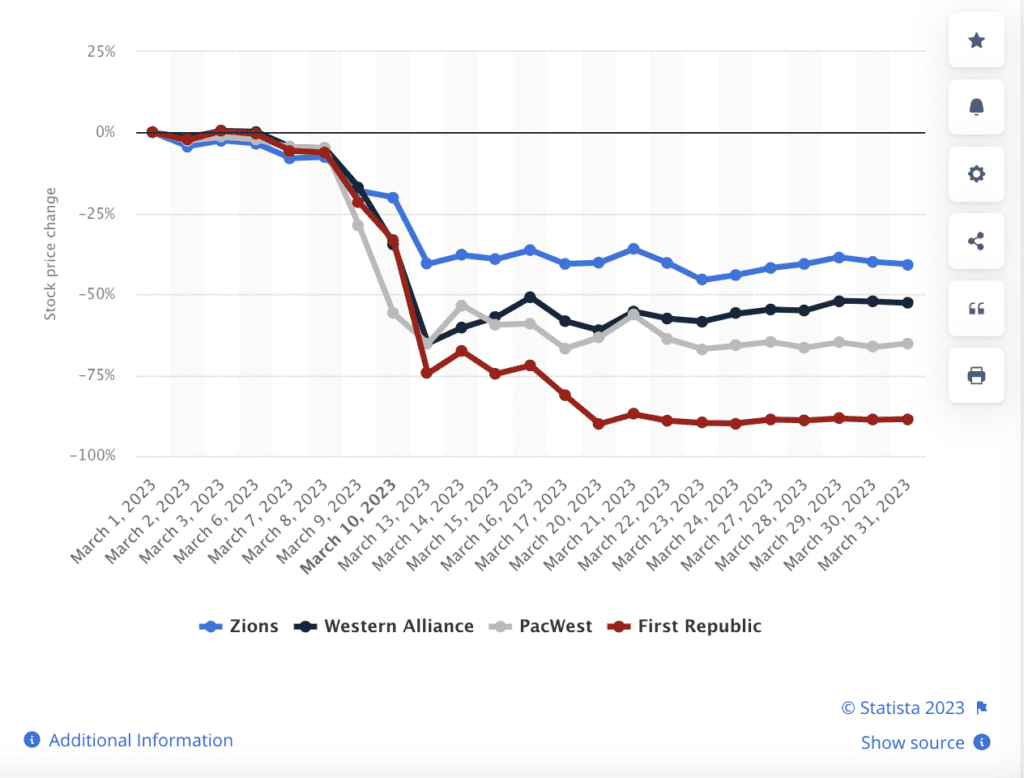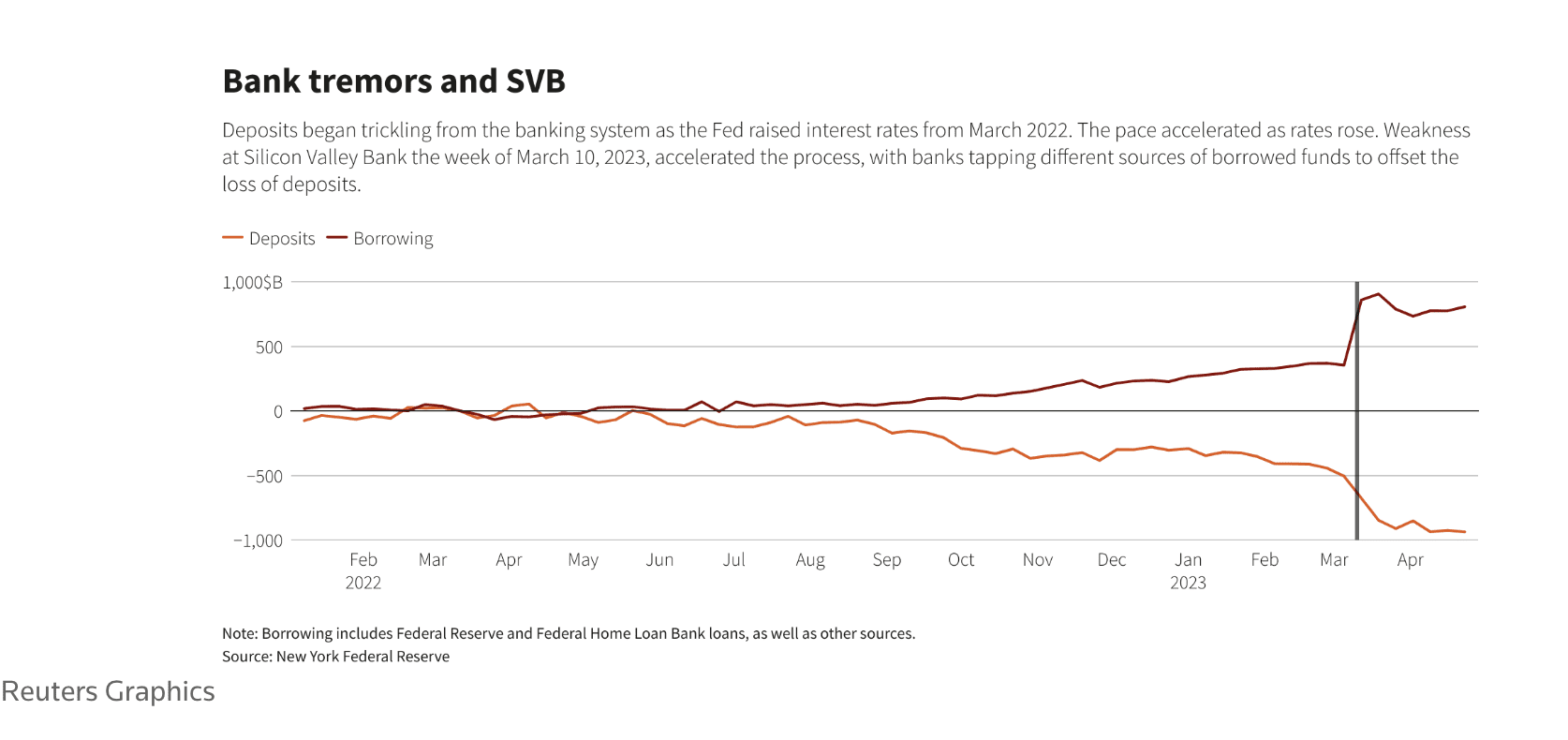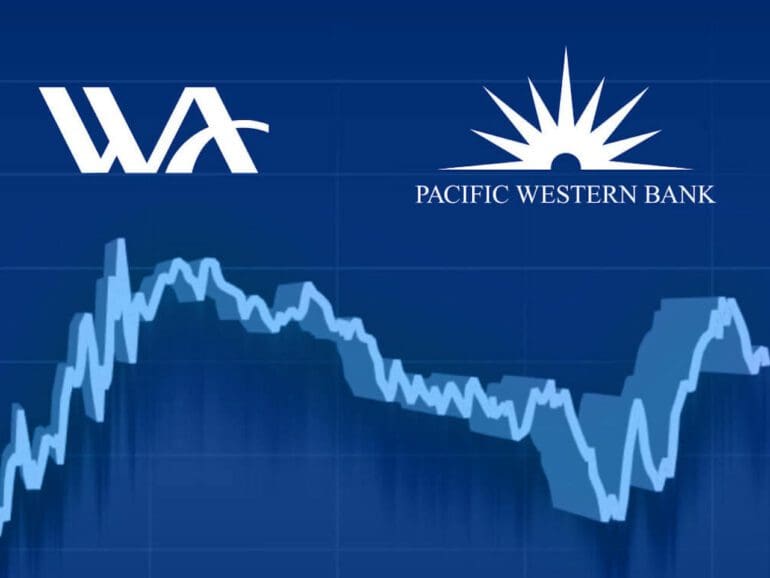The bank runs of mid-March caused tremors throughout the financial system, and regional banks have been hard hit.
During Silicon Valley Bank’s fateful weekend, many major regional banks also experienced a nose dive in stock prices. They are yet to recover. While many leaders now maintain that the financial system is stable, rates have continued to rise, leaving regional banks ever more vulnerable.

Deposits in US banks totaled $17.1 billion on Friday, May 10, a further decrease from the week prior. Small banks continued to flounder, with significant announcements providing slight relief in stock prices.
This week Pac West, a significant source for analysts’ concern in past weeks, announced a sale of its real estate loan portfolio, causing stock prices to rally. Their reasoning for the sale was to focus on their core community banking business.
Western Alliance, too, saw a stock price bump when last week they reported growth in deposits.
But the Regional Banking Indexes still wallow at a low, KBW down 25% from pre-bank run levels. Leaders and regulators still warn of continued pressure, with debt ceiling negotiations further muddying the waters.

Bloating the big banks
Steering the JPMorgan dreadnought, Jamie Dimon has risen as the crisis’ knight in shining armor. In actions echoing 1907, the bank, already dubbed “too big to fail,” swooped to the rescue, eventually acquiring First Republic Bank and protecting depositors from further upheaval.
Amid the uncertainty, many depositors pulled deposits from regional banks in favor of the big four. As a result, JP Morgan announced an increase in deposits in the first quarter of 2023, amounting to $2.4 trillion.
While “too big to fail” may be comforting, the shift comes with a trade-off.
“The too-big-to-fail banks serve a valuable purpose: that your cash is safe,” said Don Muir, CEO and founder of Arc.
“But these sector banks serve an important purpose in the technology ecosystem because they really understand the community that they’re serving.”
He explained that larger banks did not have the agility of their regional counterparts, often focusing instead on only the large client’s needs. This could mean vast U.S. financial services ecosystem areas could remain underserved.
“These banks, Silicon Valley Bank, First Republic Bank, PacWest, serve the technology sector. And they dominate the sector because they understand these unique business profiles burning more cash than they’re taking in,” said Muir.
“It’s a shame when you see the three largest players in the offline sector banking ecosystem going out of business…On the other hand, the regional banking system is flawed. You have sub-scale banks susceptible to digital bank runs in today’s economy.”
He explained, however, that the regional banking turbulence may be where fintechs could find an even stronger footing in the financial services ecosystem.
Fintechs’ flexibility could give them the edge
During March’s chaos, Arc was one of a few fintechs that mobilized to adapt to founders’ needs to transfer uninsured deposits to safer, bank-run-proof locations.
The company diversifies depositors’ banking stack using banking partnerships, ensuring clients can have deposits insured well over the FDIC $250,000 insurance limit. In early May, Arc announced they had doubled previous FDIC coverage, amounting to $5.25 million per client.
Muir explained their ability to do that was down to their position as a fintech rather than a stand-alone bank.

“It’s about as safe as possible — maximum FDIC coverage and having a too-big-to-fail custodian partner simultaneously. It’s double coverage, double protection,” he said.
He explained that while regional banks grew out of a strong relationship and understanding of their focus market, their small size has left them more vulnerable to bank runs. Those considered “too-big-to-fail” could be protected from a run on deposits. However, their size makes a detailed understanding and adaptation to the needs of smaller markets more difficult to obtain.
Fintechs target the need for customer-centric financial services that regional banks have made their niche. Being digitally native, with a focus on technology and an ability to adapt quickly, has allowed fintechs to change according to need much faster than banks of any size.
In addition, they can partner with multiple banks if necessary, opening them out for partnerships with too-big-to-fail banks and leveraging their safety.
“Digital banks can converge the best elements of both the regional banking sector and the large banks, bringing them together to serve the economy,” he continued.
Related:
Not all hope is lost
However, some remain hopeful about regional banks’ resilience, and it seems unlikely regional banks will fade into irrelevance without putting up a fight.
The pace of deposit flows out of regional banks has declined, and stocks seem to be experiencing an uptick.
On Tuesday, Brody Preston, an analyst at UBS, wrote, “No news is good news for depressed regionals.” He explained that although deposits declined, banks saw cash and other assets increase week over week, implying that across the sector, balance sheets are in “decent shape.”
The movements of the distressed banks that were previously cause for concern seem to be working, boosting confidence in the regional banking system.
“Putting it all together, this week’s results show that despite the significant discount that remains on regional banks, balance sheets are largely healthy and liquid. Single-stock bad news that seems to drive the group on aggregate are indeed single-stock issues on a fundamental level,” Preston wrote.


